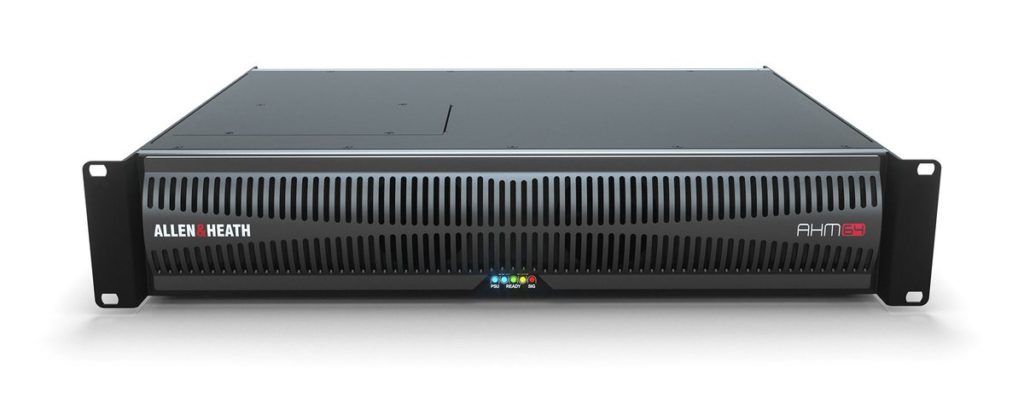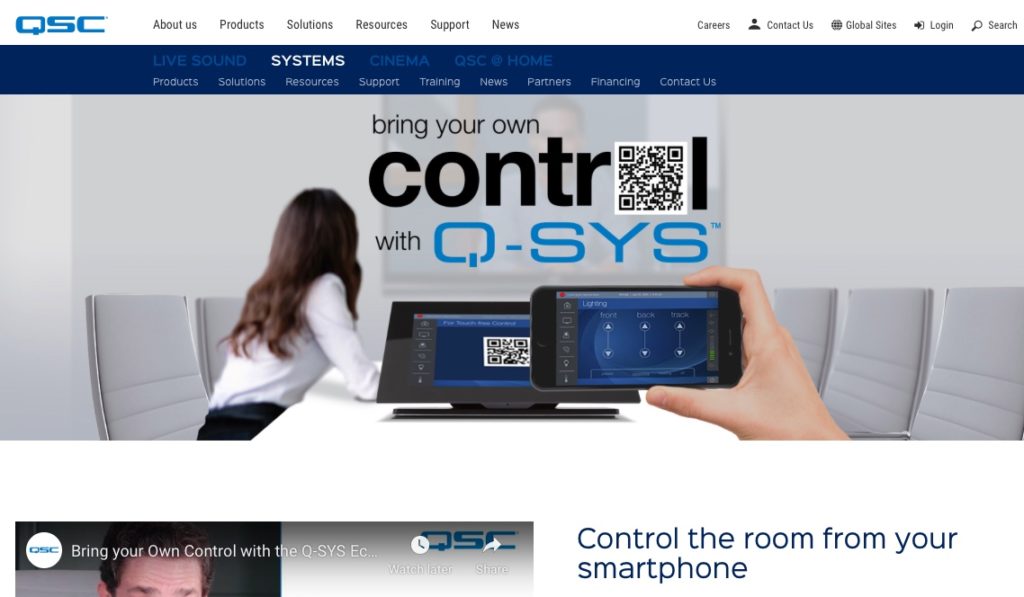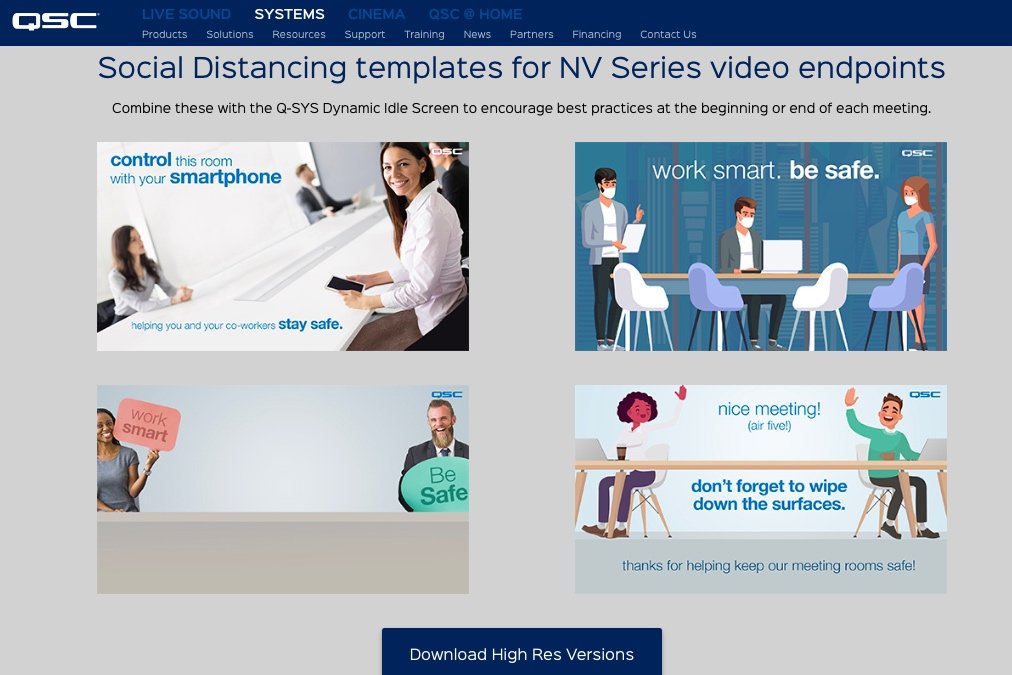News
6 Jul 2020
InfoComm Connected 2020

Subscribe to CX E-News
Everywhere and Nowhere
Boy, did I get lucky back in January. As my mouse hovered over the ‘Book Now’ button for a flight to Las Vegas in June to go to InfoComm, a little voice in my head said ‘maybe just hold off in case this virus gets out of hand’. It’s pretty much the only break I’ve caught in 2020. And so I found myself sitting at home, logging onto a website to cover my first virtual tradeshow. Spoiler alert – it’s nowhere near as good as being there.
As we are now all crushingly aware, streamed product presentations, Zoom meetings, websites, and webinars are orders of magnitude less engaging and enjoyable than actually being in a room and interacting with people, regardless of the fact that the information being presented is the same.
It’s an energy-sapping experience to sit through back-to-back streamed presentations, even if the content is great and the presenters engaging. To use an audio metaphor, its equivalent to the difference in listening to a live band through an iPhone as compared to in a concert venue; it’s the same music, but robbed of three dimensions and most of its impact.
Of course, most live material was scheduled for US time, and fair enough. Happily, there were sessions early in the day for our European cousins, and late in the day (mid-morning here) for ourselves in APAC.
AVIXA did a creditable job in hosting Q&As with notable AV boffins from around our region, including Australia’s own Peter Coman, now working in New York. It was actually nice to get to ‘go’ to these sessions, as I’m usually completely tied up on the show floor. But still, a streamed Q&A still lacks the life of being there, and was ultimately just depressing.
Bang for Buck
On Thursday 18 June our time, Swinburne University of Technology’s Scott Doyle, also President of the Audiovisual and Educational Technology Management Association, gave a fantastic presentation on ‘Using data to extend system life on a small budget’, a case study of his work at the Uni. It was a refreshing look at AV life in the real world.
Over the last three years since he started at Swinburne, Scott has headed a team that has done a full audit of all AV systems on campus. They found more than 100 spaces that weren’t even listed on the database. They’ve compiled data on everything that plugs in, standardised new space roll-outs, maintained and repaired where they can, and added an amazing degree of efficiency.
He made a business case that proved the Uni needed to increase its Capex for AV, and got them to do it. It’s paid off in reliability and ROI. The moment in Scott’s presentation that gave me pause is when he charted his Capex budget over the last three years, and then compared that to this year post-COVID, and projected to next year.
2019 saw Scott’s team have a budget of $4m with $1.5m of projects. 2020 started with a request for $2.5m overall, $1m of which was granted. The first COVID revision took that to $500K. The second took it to $0. 2021 is likely to see Swinburne’s AV budget at $500K total. When you multiply this across the entire education sector, this augurs a grim year in AV in Australia.
The ‘Exhibition’
This was the most disappointing aspect of InfoComm Connected. Now, no-one has ever had to build an experience like this before, so I’m not blaming anyone for the result, but the digital equivalent of an exhibitor’s stand was a web page with some text, videos, downloads of pdfs, and a couple of pictures.
And that was the ones that made an effort. I’m usually running around a show floor with a camera and voice recorder, attending launches on stands, having experts talk me through products, and if I’m lucky, having my eye caught by something unexpected.
You can’t replicate that. It’s also really inefficient. All of us who work in AV are familiar with the tools we use on a regular basis. When one of the brands we regularly deal with releases something new, it’s usually an improvement to an existing technology.
You can learn about this in a three-minute conversation on the stand: “Oh, your new version adds that capability, does that core function in a slightly different way, and costs less. Cool.” And you’re on your way to the next shiny thing.
Getting to the same point by watching videos and reading pdfs takes ten times longer. You also miss getting a sense of the physicality of the product – what’s the build quality like? How does that screen really look? What does that speaker actually sound like?
The Gear
Adamson
Adamson Systems Engineering made the biggest splash of the show with their new CS-Series – AVB enabled, powered line arrays, subwoofers, and point source boxes, backed with new power, data, and signal management tools.
The new CS-Series is comprised of the ultra-compact CS7 two-way, full-range array enclosure; the CS7p point-source enclosure; and the companion CS118 subwoofer, along with the sub-compact CS10 two-way, full-range array enclosure; the CS10n narrow-dispersion array enclosure; the CS10p point-source cabinet; and the companion CS119 subwoofer.
The turnkey CS Upgrade Kit allows any existing S-Series cabinets to be easily converted to CS models in minutes by simply removing four screws, connecting the CS Jackplate with the provided wiring connectors, and switching the front grille.
CS-Series also includes four rack-mounted products designed to provide the necessary tools to get the highest level of performance out of the CS-Series.
The CS Gateway is a 16 x 16 matrix with 16 channels of DSP, containing dual-LAN, Milan-ready AVB, AES/EBU, and analog connections. The CS NDS is a network and analog patch bay that allows users to send redundant audio and control to CS loudspeakers on a single network cable. The CS PDS ensures that all CS-Series systems receive ample power, regardless of region, and also allows the user to monitor consumption data, both per power output as well as overall draw.
The CS Bridge is designed to replace existing network infrastructure in Adamson’s E-Rack, allowing users to seamlessly integrate the CS-Series into their existing inventories by converting dual-LAN, Milan-ready AVB signal to AES/EBU, while also offering six channels of DSP per unit.
Shure
Shure extended and ‘completed’ their IntelliMix and Microflex range of conferencing and collaboration audio products with the introduction of a new linear array microphone, the MXA710, a networked ceiling speaker, the Microflex MXN5 Networked Ceiling Loudspeaker, and tied it all together with a global mute control, the Networked Mute Button.
Slickly presented in a virtual product launch that took place the Friday before InfoComm, the full range is now a compelling one-manufacturer solution for install.
The MXA710 comes in a two foot long or four foot long model, and can be mounted under or next to screens. You can even get a dummy unit if you want to mount it next to a screen and maintain symmetry! Like the ceiling tile MXA910, it runs Shure’s IntelliMix DSP, is PoE, and outputs Dante/AES67.
The MXN5-C Networked Ceiling Loudspeaker is a powered active 2-way driver system with a 13.3cm woofer that runs on PoE and some DSP, including EQ, delay, limiting and a signal/tone generator. I/O includes two Dante inputs and one Dante output, which is handy for setting up an AEC reference.
The MXA MUTE is a configurable PoE-powered mute button that ties the system together. Integrators use Shure’s Designer system configuration software for easy setup and configuration of all of the products in their IntelliMix and Microflex ecosystem, and facility managers can use Shure’s SystemOn asset management software for remote management and troubleshooting.
Bose
Bose released the SoundComm B40 Headset, for professionals who work in high-noise, communication-critical environments. The new SoundComm B40 headset is engineered to deliver the best combination of noise cancellation performance, clear communication, comfort, and durability to live event professionals, production crews, and sport sideline coaching and support staff.
Sennheiser
Sennheiser announced a major update of its Sennheiser Control Cockpit software. Besides design and usability enhancements, the latest version 4.0.0 now adds the ability to monitor the new SpeechLine Multi-Channel Receiver and the EM 6000 receiver from Sennheiser’s Digital 6000 series, in addition to evolution wireless G3 and G4, SpeechLine and the TeamConnect Ceiling 2 microphone.
This makes the software a universal tool for corporations and education facilities.
Sennheiser Control Cockpit also now features a “location-based Mute” functionality: all devices in a room, for example, can be grouped and their mute switches synchronised, so that all devices can be muted and unmuted together, either centrally via the Sennheiser Control Cockpit or locally on one of the devices.
Location-based Mute is available for TeamConnect Ceiling 2 and SpeechLine Digital Wireless, including the new Multi-Channel Receiver. Also, the software now employs SSL encryption to make data transmission between the user interface and the host server even more secure.
Allen & Heath
Not actually released at InfoComm, but completely new to me is the AHM-64; an audio matrix processor for sound management and installation. It is designed for audio distribution, paging, conferencing and speaker processing in a multitude of environments including corporate, hospitality, education, event and multi-purpose venues, retail, theatres, cruise ships and sports venues.
The AHM-64 processor is complemented by an extended ecosystem of remote audio expanders, remote controllers, interfaces, apps and software. A family of portable, rack-mountable or wall-mount audio expanders is available with a choice of proprietary point-to-point Layer-2 or Dante transport protocols.
It sports a 64×64 processing matrix, 12×12 local analogue I/O, and an I/O port for audio networking, up to 128×128. You can add an optional 96kHz 64×64 Dante card that’s AES67 and DDM ready, there’s a 128×128 built-in SLink port for audio expansion, and the beast can handle 64 configurable processing outs, which gives you up to 64 mono/stereo zones.
Audinate
While new products at InfoComm Connected with Dante ports on them numbered in the dozens, Audinate itself released these charming little numbers.
Audinate Dante AVIO
The Dante AVIO Bluetooth Adapter connects to your Dante network and supports 2 x 1 channels of wireless audio, allowing PCs and mobile devices to playout and receive audio with any of your Dante-enabled devices using only a Bluetooth connection.
Connect audio applications like media players and conferencing software to speakers, microphones, mixers and DSPs on your network. The Dante AVIO USB-C edition delivers the same great performance as the AVIO USB adapter and delivers power from any PoE network switch to your mobile device for continuous connectivity.
It supports 2 x 2 channels of bidirectional audio, allowing PCs and mobile devices to playout and record audio with any Dante-enabled devices over a standard IP network. Use audio applications like media players, conferencing software, presentations and recorders with network connected speakers, microphones, mixers and DSPs.
Cost effective, compact and built for the road, the Dante AVIO family of adapters bring the modern network connectivity that every audio pro needs in their toolbox.
QSC
Continuing to totally dominate in the world of installation and integration due to sheer innovation, QSC continued its winning streak by adding the COVID world’s hottest functionality – BYOD control so we don’t all have to share touch screens.
This new functionality allows users to access specific Q-SYS UCIs without touching the room’s touch screen controller. You can add a custom QR code to your UCI, and users simply open their camera app, aim at the QR code and instantly take advantage of the room controls on their smartphones.
Either brilliantly or depressingly, QSC also produced a raft of resources for programmers and integrators to help them implement social distancing logic, social distancing video signage, safety timers, and audio reminders to remind meeting goers to clean and reset the room at the end of each meeting.
QSC’s social distancing resources
Panasonic
Again, not new to InfoComm Connected but completely new to me, is Panasonic’s Kairos, an IT/IP-centric live video processing platform.
There’s three parts to the system; the Kairos Core mainframe, the Kairos Control hardware controller, and the Kairos Creator control software. It’s aimed squarely at video for live events. It incorporates newly developed software that processes ST 2110 and NDI streams of any resolution.
This platform achieves higher performance by fully utilising the power and flexibility of its CPU and GPU, balancing total processing load without the configuration constraints of traditional hardware-based systems. This open architecture platform facilitates the linkage of diverse external sources and destinations as well as the integration of hardware and software systems.
Kairos fully supports baseband and IP signals such as SDI, ST 2110 and NDI, in any combination and also supports PTP (Precision Time Protocol) synchronisation. As a native IP system, Kairos is well suited to be used for remote video production as part of a completely IP-based environment.
Mixed input sources with different resolutions, such as HD and UHD, can be processed simultaneously. For instance, it enables the production of videos not only in the standard 16:9 format, but also in the 32:9 format suitable for display walls.
Kairos is not restricted by the number of MEs or keys, like a conventional switcher, and allows as many layers as the GPU capacity permits. Keys and scaling can be set in each layer without any restrictions, and various effects and keys can be added to each layer. Kairos’ processing latency can be as low as one frame, so sports and live performances can be presented with the ambience intact and sync can be achieved easily.
CX Magazine – July 2020
LIGHTING | AUDIO | VIDEO | STAGING | INTEGRATION

Entertainment technology news and issues for Australia and New Zealand
– in print and free online www.cxnetwork.com.au
Lead image: InfoComm Connected 2020 Instagram
© VCS Creative Publishing
Subscribe
Published monthly since 1991, our famous AV industry magazine is free for download or pay for print. Subscribers also receive CX News, our free weekly email with the latest industry news and jobs.























